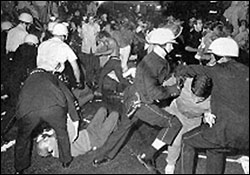When we discussed in class that for this assignment a specific event would probably be the easiest course to take, I immediately thought of the 1968 Democratic Convention. While I was interested in this topic and had done previous study on it, I was unsure as to how many pictures were actually available for the public. I first did a Google image search just to see what was out there and came up with a few interesting shots. However, my fear of copyright infringement actually prevented me from using a lot of interesting photos. Many of the photos that appeared in the Google Image search had very unclear origins. I mostly stuck with Wikipedia because we had discussed in class how to cite Wikipedia and to me it seemed the most fool proof.
Originally I wanted to just find a generic picture of Chicago to set the scene for the convention. However, the only picture I could find of Lincoln Park specifically, the scene of a lot of the riots, was in winter, the park covered with snow. This seemed inappropriate to me since the convention took place in the summer. The only other pictures of Lincoln Park I found were from poster websites so I quickly abandoned that idea. I started with Mayor Daley because when I thought about it he was such an important force behind Chicago politics and especially the events surrounding the demonstrations. After I had the idea to use pictures of people the rest fell into place easily.
Instead of using the general city picture that had originally planned, I ended up finding the great picture of the riots which is much more fitting for the essay as a whole. Also while I had originally wanted a picture of Tom Hayden from the 60s but when I found the more recent picture of him, speaking at a recent protest I thought that would be a good way to tie the events of the 68 convention to more recent conventions and current politics.
Overall, I really enjoyed doing the photo essay because I got to look at a lot of interesting pictures, even if I couldn’t use them all. I also found it a somewhat anxiety ridden assignment since the consequences of copyright infringement can be very big. However, I think that pictures are important when writing about history, especially more modern history where there is certainly a wealth of photographs to choose from. Photos can certainly enhance the story of history and add valuable visuals when discussing important events.




